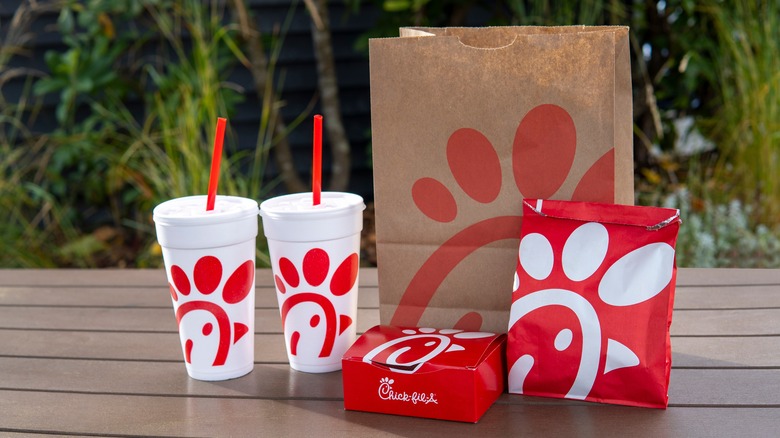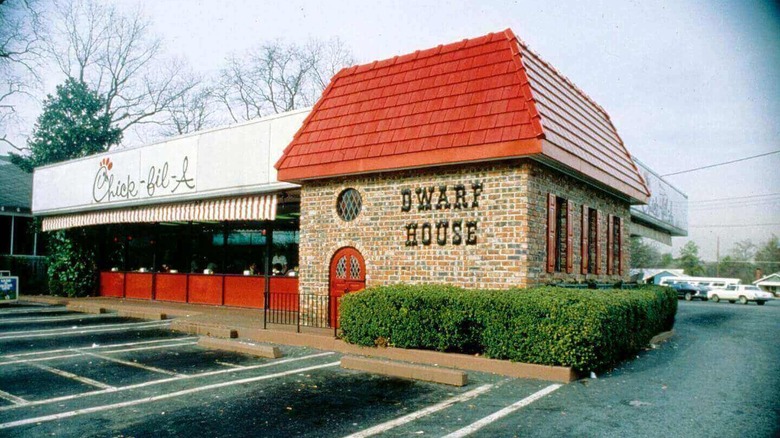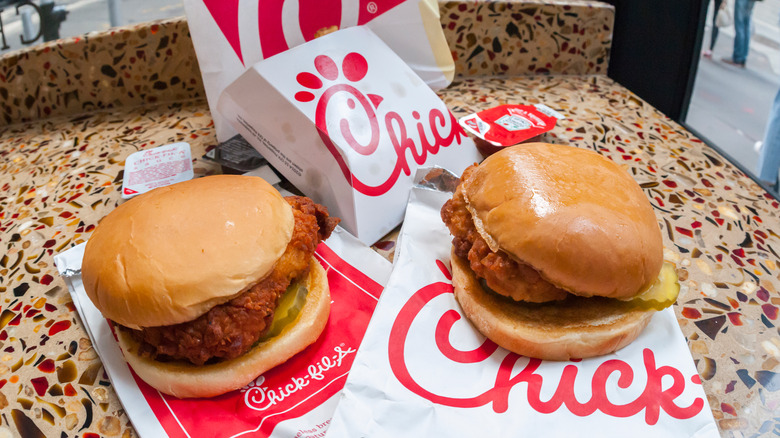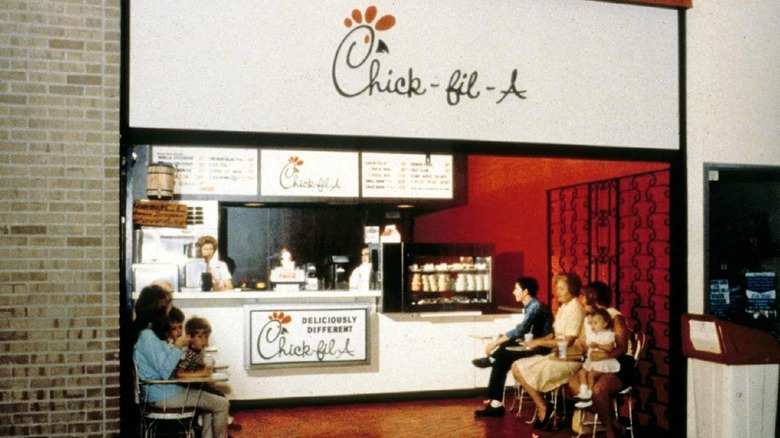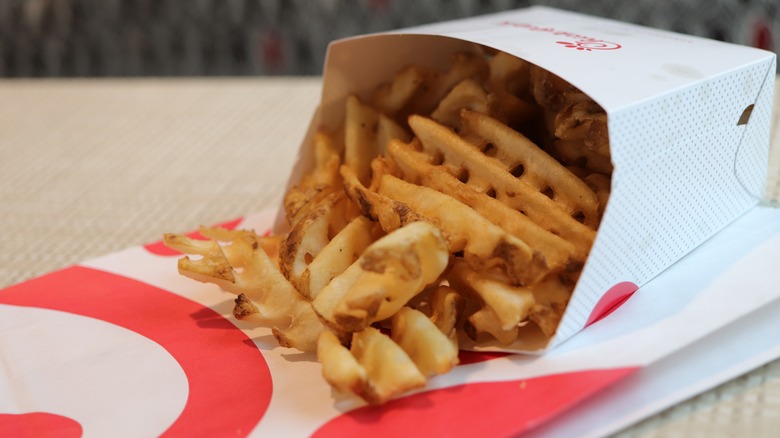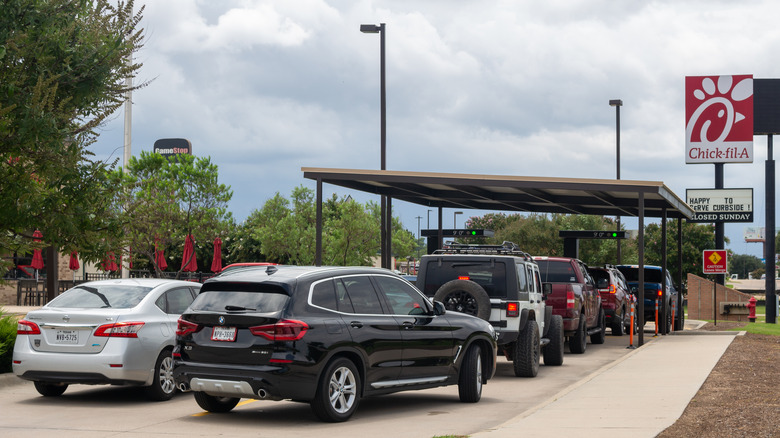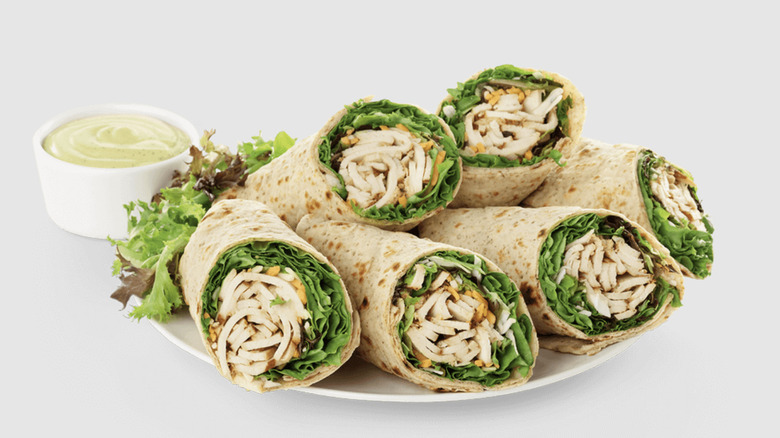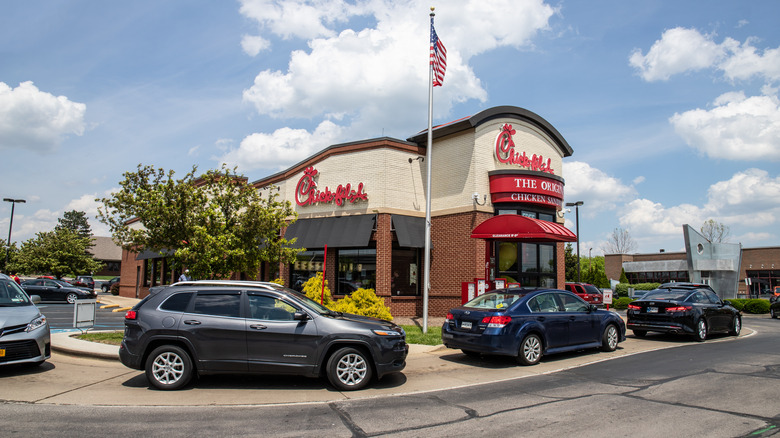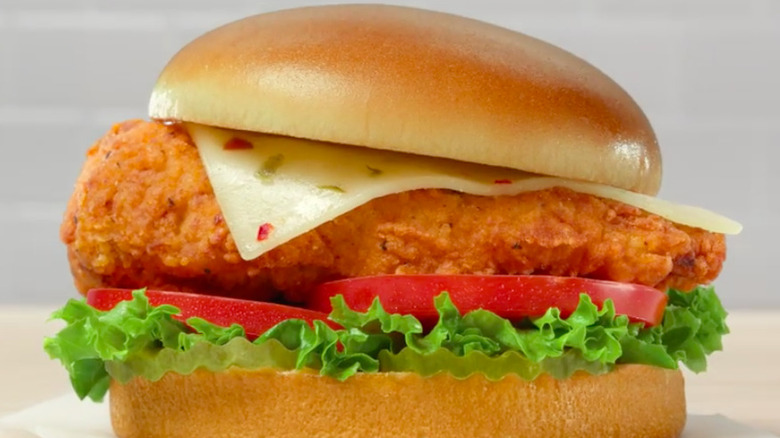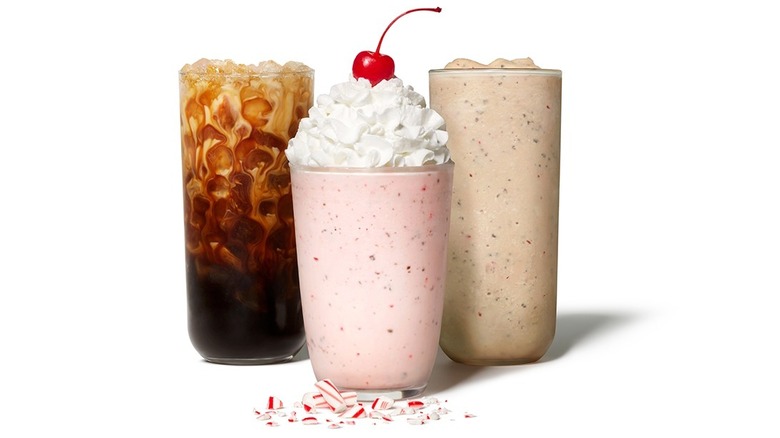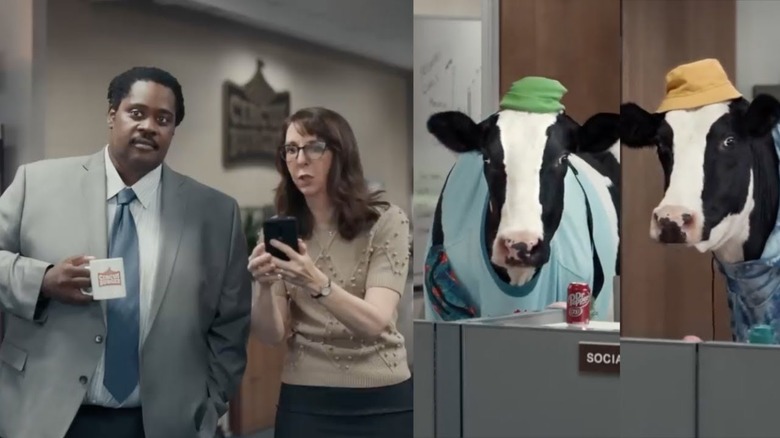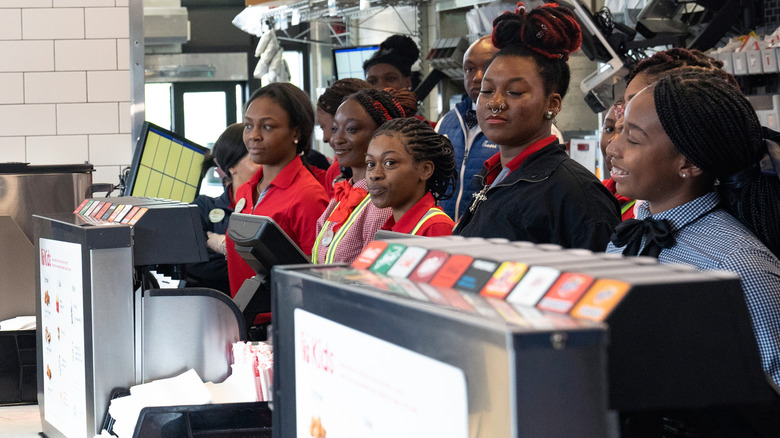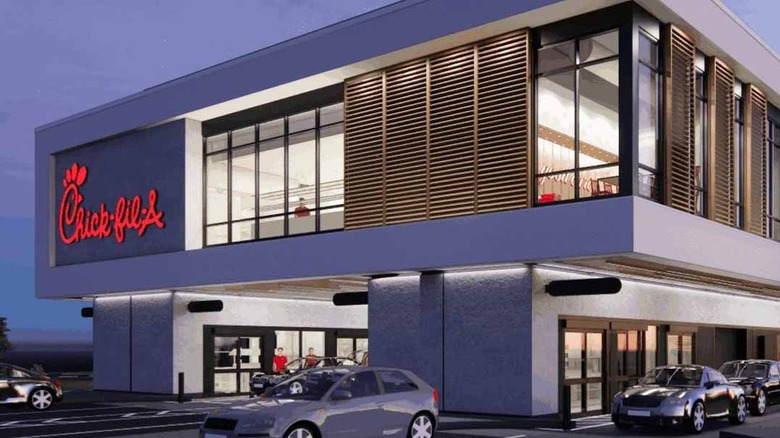The Evolution Of Chick-Fil-A
There's no denying America's love affair with fast food and fried chicken. While Burger King, McDonald's, and Wendy's slug it out in the battle of the burgers, the likes of Popeyes and Kentucky Fried Chicken are squaring off in the fight for chicken supremacy. But there's a third player that has fast become the dominant force in the chicken wars, a restaurant chain with humble Southern beginnings that has survived decades to carve its name into the hallowed walls of the Fast Food Hall of Fame: Chick-fil-A.
Though Chick-fil-A's first restaurant opened in 1967, its history stretches back decades earlier, undergoing some major changes between then and now. Its menu has expanded and received multiple facelifts, with new items frequently added or taken away. It might even surprise you to learn what strange entrees were once served — there was a time when the chain offered oatmeal. From the very first sandwiches in the 1940s to today's Spicy Chicken Deluxe, Waffle Fries, and Lemonade Combo, we're exploring the evolution of Chick-fil-A.
Chick-fil-A was founded in 1946 ... under a very different name
We've talked about what it was like to eat at the first Burger King, but for Chick-fil-A's first customers, things were a little different. The original restaurant founded in 1946 wasn't even called Chick-fil-A, and its menu didn't have much in common with what you'd expect to find at one today.
The Dwarf Grill, as it was first known, didn't even serve the ubiquitous chicken sandwich. It was located in Hapeville, Georgia, not far from Atlanta, and was the brainchild of Truett Cathy, a Southern Baptist and World War II veteran. Alongside his brother Ben, Truett decided to get into the restaurant business after his service ended in 1945, initially creating the Dwarf Grill as a small-town diner with a menu that reflected the simple concept.
Rather than serving the items we all know and love today, the Dwarf Grill served burgers, fries, macaroni and cheese, and Southern American favorites like cornbread, collard greens, and sweet potato souffle. But while the Dwarf Grill later became Chick-fil-A, the first restaurant never changed its name and still operates in the same location as The Dwarf House.
The origins of the iconic chicken sandwich
Despite the wide array of menu offerings, the first iteration of Chick-fil-A didn't have the item that has since become the face of the entire company: the original breaded Chicken Sandwich. Unique for its simplicity, the sandwich is recognizable for its use of pickle chips and its buttery bun. The Chicken Sandwich wasn't a single stroke of genius though, and it took Truett Cathy more than 20 years to create it after founding the Dwarf Grill. But when he did, it put his restaurant on the map.
If you think the arrival of the classic Chicken Sandwich kicked off the company's change to Chick-fil-A, think again. The restaurant first introduced the sandwich while it was still the Dwarf Grill, years before it took on its now-famous name. Cathy himself created the original recipe, and it's the same today as when it was first invented in 1964. Thanks to Cathy's entrepreneurial spirit, he invented an icon after being offered a large supply of boneless, skinned chicken breasts that an airline food supplier couldn't fit on the small trays.
Cathy brought the meat home to his mother's kitchen and developed a new recipe for breaded chicken. Thanks to the miracles of an industrial pressure cooker, his method of cooking chicken allowed for tender meat to be cooked hot and served in just a few minutes. Today, the company sells more than 500 million chicken sandwiches in a year.
The chain expanded into shopping malls in the 1970s
These days we're all used to seeing Chick-fil-A's in most cities and major towns from coast to coast. But even when the chain was getting its start and expanding past its first few restaurants in Georgia, it was almost unrecognizable compared to what we'd expect to see today. When it became Chick-fil-A in 1967, its first official opening was inside the Greenbriar Mall. Throughout the 1970s, the company focused almost exclusively on opening new restaurants in malls around the country.
It's important to remember that the concept of the indoor shopping mall was still a relatively new idea in the 1970s and seen as a novelty. But where some may have seen a kitschy fad, Chick-fil-A saw a major opportunity, perhaps foreseeing the growing popularity of the shopping mall that became a phenomenon in the '80s.
During the era of second-wave feminism, when more and more households had two working parents with less time to cook, families looking for Chick-fil-A could find it at the all-in-one shopping mall. This made it a convenient dining experience and demonstrated the company's vision, as just about every fast food chain now operates in mall food courts.
The 1980s saw a menu explosion ... and the introduction of the signature fries
For over a decade, Chick-fil-A was almost exclusively found in shopping malls, but that all changed in the 1980s when the first standalone restaurant was constructed. As surprising as it might be to learn, it wasn't until 1986 that Chick-fil-A could be seen as a free-standing restaurant. To coincide with this major shift in corporate strategy, the decade also saw some changes to the menu, the biggest being the introduction of its world-famous Waffle Potato Fries in 1985.
Even before the first free-standing Chick-fil-A, the menu was already beginning to bulge. In 1982 the chain added one of its best bite-sized snacks, introducing its take on Nuggets. A signature bowl of Chicken Noodle Soup arrived the same year, and when the first standalone restaurant opened in 1986, along came the iconic Chicken Biscuit, followed by a kid's meal two years later. All of these items remain menu staples today.
Before the end of the 1980s, Chick-fil-A added one major new food item: a Grilled Chicken Sandwich, served with hash browns and a variety of salads for the first time. The '80s were a huge decade for the company, but it went beyond just the menu; in 1984, Chick-fil-A opened its first corporate headquarters.
How drive-thru became integral to the business
Fast food chains have long capitalized on customers' growing dependence on car travel, with the most popular form of vehicular food acquisition being the drive-thru. After chains like McDonald's and Wendy's started offering it in the 1970s, Chick-fil-A followed suit in the 1980s.
These days, you might even be familiar with Chick-fil-A's unique two-lane delivery system, developed and implemented in 2021 to aid with the flow of customers. Following the COVID-19 pandemic, when fast food was practically the only reasonable option for eating outside the home, businesses like Chick-fil-A saw an enormous influx of new patrons, and many struggled to keep up with demand. The two-lane drive-thru was the solution for Chick-fil-A, and it has since become a common sight at restaurants around the country. When things get backed up, hosts have even been known to come outside with touchscreen devices to take orders right from your car.
But the strangest drive-thru Chick-fil-A's were in the 1990s when the company experimented with restaurants that were drive-thru only. Other chains have since toyed with this model, offering no seating or front-of-house service. While they might not be ubiquitous, Chick-fil-A still operates a handful of drive-thru-only locations.
A new millennium menu overhaul
Any good restaurateur knows it's important to refresh their menu from time to time to ensure the experience never gets old for customers. Chick-fil-A is no different, and through the years the chain has introduced new items and removed poor performers. In the 2000s, though, it revamped the menu in what might be the biggest decade of updates since the Dwarf Grill became Chick-fil-A.
Stepping away from the bun, the Grilled Chicken Cool Wrap arrived in 2001, which included sliced grilled chicken, lettuce, and shredded Monterey Jack and cheddar cheeses in a flatbread wrap. It's still on the menu today, and the same holds for the Chick-n-Mini's and the breakfast Fruit Cup. As for the line of Breakfast Burritos that contained sausage, peppers, and onions, it has been replaced by the Hash Brown Scramble Burrito. The newer burrito combines sliced chicken nuggets, hash browns, scrambled eggs, and two kinds of cheese, but no matter how good it is, there are still rabid fans of the original who want it back. Meanwhile, 2006 also gave us the first handspun milkshakes, which we can't imagine living without.
The Chicken, Egg, and Cheese Bagel was available in the 2000s but has since been discontinued. We may never know why bagels got the axe (the company's website offers only vague platitudes), but it's possible that a popular Northeastern staple food just couldn't catch on nationally. Some fans, of course, have found menu hacks to recreate their discontinued favorites.
Chick-fil-A opened its 1500th restaurant in 2010
For a while, Chick-fil-A seemed to be something of a regional craze, available mostly in the South before it began branching out to other areas of the country. But by 2010 it was one of the fastest-growing fast food franchises, and that year it opened its 1,500th store. While that was a nice round number, it still put the chain well behind the likes of McDonald's, which had more than 30,000 locations. Financially, though, Chick-fil-A was doing exceptionally well, and in 2012, its profits hovered around $4.6 billion, around a third of Subway's, despite Subway dwarfing it in store count.
If you think the chain was doing well then, think again because the next six years saw the kind of growth executives salivate over. By 2019, revenue had nearly tripled, and the $12.5 billion generated was enough to catapult the chain close to the top of the fast food rankings. Trailing only McDonald's and Starbucks in systemwide sales, Chick-fil-A's third-place finish put it ahead of Burger King, Taco Bell, and Chipotle.
That explosion continued and in 2020, amid an ongoing global pandemic, the company's total systemwide sales clocked in at an eye-popping $13.7 billion, a 12.7% increase over the previous year. That's also nearly three times what it was bringing in less than a decade earlier.
Spicy options changed everything in the 2010s
Throughout its long history, even the most untrained eye could see that Chick-fil-A was trying to keep its menu traditional. It didn't offer radical, experimental foods like many of its competitors to shake up the status quo. But in the 2010s the chain was all but forced to go bold with the addition of several menu options that turned up the heat, as so many other food companies were doing the same with huge success as customers discovered the joys of spicy foods en masse.
Kicked off in 2010, the first of the hot new offerings was the Spicy Chicken Sandwich, which took the classic original and doused it with hot and flavorful spices. But that certainly wasn't all because a year later came the Spicy Chicken Biscuit, and in 2016, the Spicy Southwest Salad (which includes a surprising ingredient). Those weren't the only experimental items that decade. 2012 brought us the Chocolate Chunk Cookie, but more importantly, in 2015 we got a gamechanger, the Frosted Lemonade, which has become a common soda substitute for Chick-fil-A diners.
But we'd be remiss if we didn't mention the Chicken Sandwich Wars of 2019. With the ever-growing popularity of Chick-fil-A, competitors tried offering their own versions of the Classic Chicken Sandwich. Popeyes, Burger King, McDonald's, and even Taco Bell all came up with a spin on the iconic entree, but none remain as popular as the original.
A look at Chick-fil-A's seasonal menu items through the years
McDonald's isn't the only fast food favorite to introduce specialty items on its menu for holidays, like the famous Shamrock Shake (which was available earlier than normal this year). Chick-fil-A does it often enough that there's almost always a special seasonal treat on the menu. For spring 2024, the menu features a limited edition Cherry Berry flavor of drinks — available as a sweet tea, lemonade, and a frosted lemonade. But these seasonal additions aren't always the same every year.
The first seasonal menu items popped up in the late 2000s, with offerings like the Peppermint Chocolate Chip Milkshake that eventually became an annual tradition. It was quickly joined by other seasonal flavors, like Coffee Caramel, Mint Cookies and Cream, and Peach.
It's not just milkshakes though, because the seasonal menu at Chick-fil-A is more than just for those with a sweet tooth. There was also the Chicken Tortilla Soup, first sold in 2012 which continues to make periodic returns to the menu, and the Smokehouse BBQ Bacon Sandwich summer special in 2017. More recently, the chain offered a sweet dessert item that one chef wants to bring back.
Chick-fil-A's marketing has evolved since its humble beginnings
The evolution of Chick-fil-A has seen the restaurant go from a single diner to a global operation that can be found in Canada and Mexico. There are even plans to open locations in Europe and Asia beginning in 2025. It's not just that it has grown and added items to its menu, though. The way the chain has advertised, marketed, and portrayed the brand to customers and in the media has changed as well.
From the beginning, Chick-fil-A's brand was all about the chicken (you might not realize it, but the "A" in the name was also meant to stand for the "A" grade of food it offered). The logo has always had a cartoon chicken over the first "C," and early ads sometimes included clever play-on-words. A 1970s ad proclaimed: "Here's that new chick!" when showcasing the chicken sandwich. Meanwhile, a 1980s TV commercial highlighted that Chick-fil-A doesn't use flashy gimmicks to sell sandwiches, focusing solely on good food.
In 1995, however, the chain introduced its first popular mascot, and it happened to be a cow. With the slogan "Eat Mor Chikin," the restaurant attempted to use good humor and vocal animal characters to drive home the point that it was different than other fast food options available. It's proven such a popular campaign that it's still the slogan used today.
The state of Chick-fil-A today
At the end of the 2010s, Chick-fil-A was quickly evolving into one of the biggest players in fast food. It may not have had nearly the number of stores as some of its more well-known competitors, but its revenue was soaring. By this time, it had shot past $10 billion in sales, and that explosion continued. As of the end of 2023, the company sits at third place in the fast food industry — still trailing only McDonald's and Starbucks — with an astonishing $21.6 billion in systemwide sales.
Location-wise, Chick-fil-A continues to grow, too. After surpassing 1,500 stores in 2012, the chain boasted over 2,700 restaurants in 2021, good enough for 18th place in the country, ahead of Jimmy John's, Panera Bread, and Jersey Mikes, with more outlets opening since. As impressive as that is, Chick-fil-A's success is tied to its ongoing popularity, with reports of long lines and packed restaurants a regular occurrence. Standalone stores (not including mall-based restaurants) were recently ported to have brought in an eye-watering $9 million per year.
Chick-fil-A is evolving its restaurants
Chick-fil-A has long been committed to modernization, and over the last decade, mobile ordering has become an increasingly popular choice. In 2023, the company announced that one of its two drive-thru lanes would become a mobile pickup line exclusively, to speed up the ordering process.
Around the same time, Chick-fil-A announced it would be testing out a pair of radically different new restaurant designs that update the dining experience by "reimagining hospitality in a digital-focused world," per the press release. One of these concept stores will feature a unique, two-story drive-thru design while the other will boast a building designed for walk-up, on-street ordering. Both will feature a new system for digital ordering that is hoped to improve the already great hospitality and customer service. Look out for openings in Atlanta and New York City sometime in 2024.
"Digital orders make up more than half of total sales in some markets –- and growing -– so we know our customers have an appetite for convenience," said Executive Director of Restaurant Design Khalilah Cooper in the release. "Understanding this desire for convenience, the locations for these tests were intentionally selected with the customers in mind, giving them more control over their desired experience and cutting down wait-time, while continuing to provide genuine hospitality and care to every guest."
